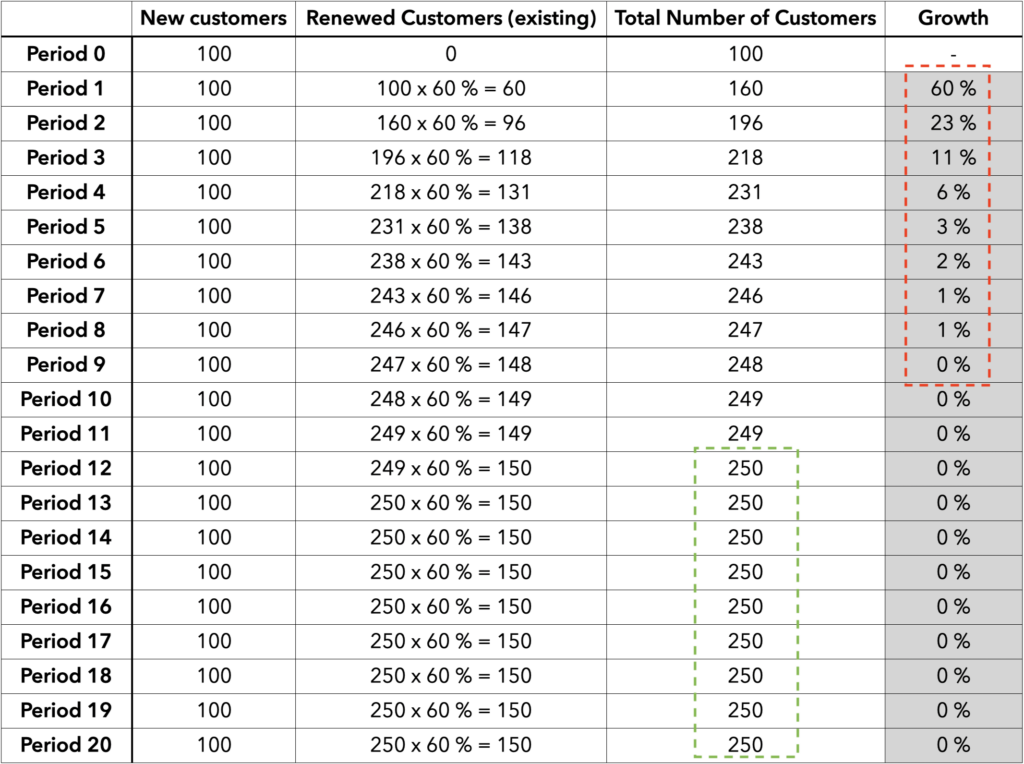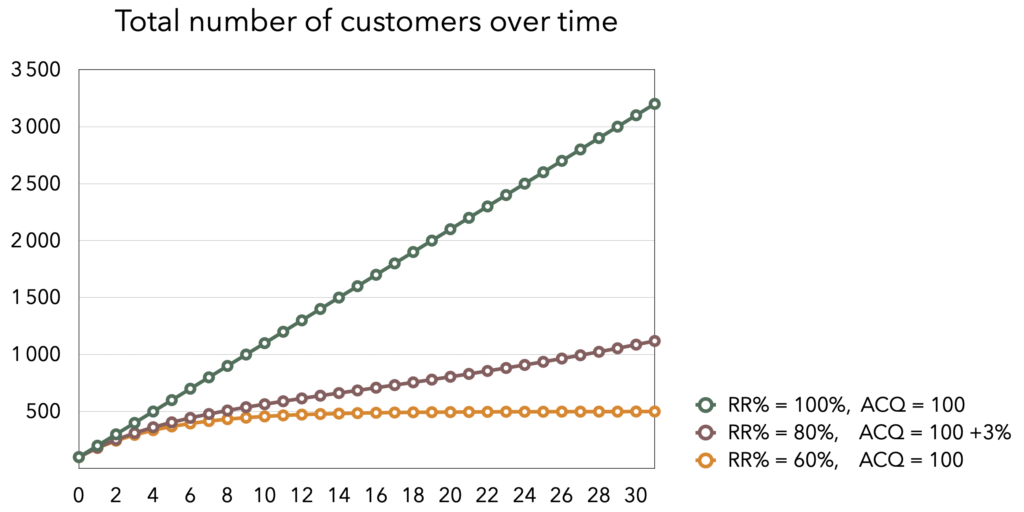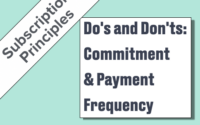Why growth slows down? Is infinite growth possible?
Summary
It’s normal ! A subscription business is unlikely to grow infinitely. It will tend towards a maximum. The conditions for infinite growth are difficult to achieve.
1. What drives the growth decline?
When launching my subscription business, I start by acquiring only new customers during the initial period. At the start of the next period, I renew existing customers while continuing to acquire new ones. And so on.
Looking at data, the growth starts very strong but slows down very quickly to low single digit and finally plateaus at zero. This phenomenon is expected because the number of customers tends to a maximum. When the maximum is reached, there’s no growth anymore.
Not convinced yet?
Let’s take a simple example to understand the growth in a subscription model.
My business is a grocery delivery company:
I acquire 100 new customers each period.
My Retention Rate (RR%) is 60%
Growth is calculated as the total number of customers period over period.
Let’s put these data in the table below for a few periods:

Table #1: New Customers + Existing Customers = Total Customers
In the table above, the Initial growth is very strong but declines quickly:
- During period 1: we lose 40 customers and we add 100. A positive difference of 60 which goes from 100 customers to 160. Growth = +60%
- During period 3: we lose 78 customers and we add 100. A positive difference of 22 which increases from 196 customers to 218. Growth = +11%
- From period 12 onward: we lose 100 customers and add 100. Growth = 0%
Always remember that in a subscription business:
- the number of subscribers increases until the Churn equals the Acquisition. From this point on, growth becomes null.
- 📍the number of subscribers tends towards a maximum which only depends on the Retention Rate and Acquisition.
2. Under which conditions could I grow infinitely?
As I showed in my previous article, the number of subscriptions tends towards a maximum which is reached when the Churn equals the Acquisition. Therefore, I have 2 options left to achieve infinite growth: no Churn or the Churn is always lower than the Acquisition.
- No Churn. Retention Rate is 100%. In this case, I don’t lose any customers, the Acquisition of each period adds up. ⚠️ However, growth still decreases as Acquisition becomes smaller in proportion to the total of existing customers.
- Churn is always lower than Acquisition. The Retention Rate is less than 100%, but the Acquisition constantly growing.
Let’s put this on a graph to see the different cases :

Graph #1: Total number of customers over time
The graph above shows the number of subscribers according to the periods:
- 🟢 Green line: RR% = 100%, Acquisition is constant. Total number of customers is unlimited. Growth is infinite.
- 🟠 Orange line: RR% = 60%, Acquisition is constant. Total number of customers is limited. Growth starts strong and slows down to zero.
- 🟤 Brown line: RR% = 80% and Acquisition growing by 3% each period. Total number of customers isn’t limited. Growth is slow but continuous.
The conditions for a constantly growing Acquisition depends on the specifics of the market ; for instance if my TAM (Total Addressable Market) is expending.
📍A Subscription business tends towards its maximum. The initial growth is high and decreases as it reaches its limit.
Key Takeaways
- A subscription business tends towards a maximum defined by 2 parameters: its Retention Rate and its Acquisition. Infinite growth is very difficult or unlikely.
- The more mature a subscription business is, the less its growth… as it has probably already reached its maximum.
- You must constantly work to improve your Retention Rate to tend towards 100% while setting an Acquisition objective higher than the Churn.



